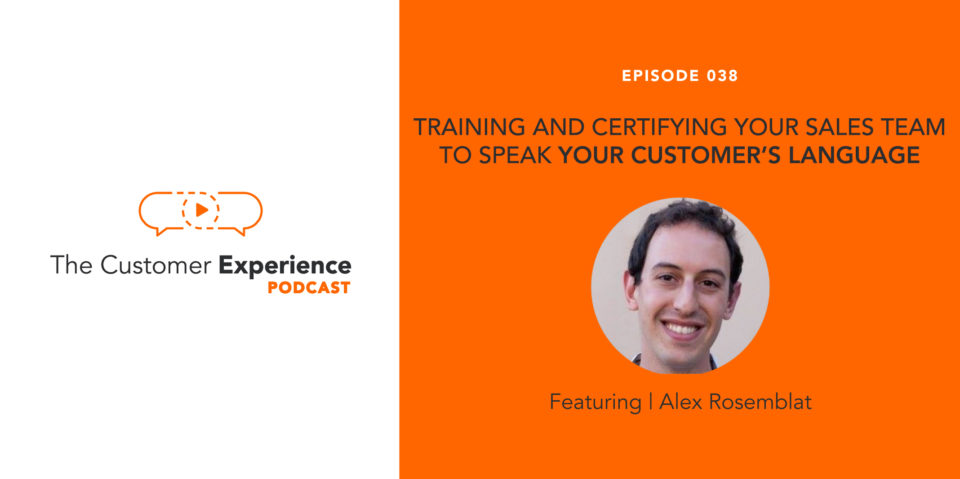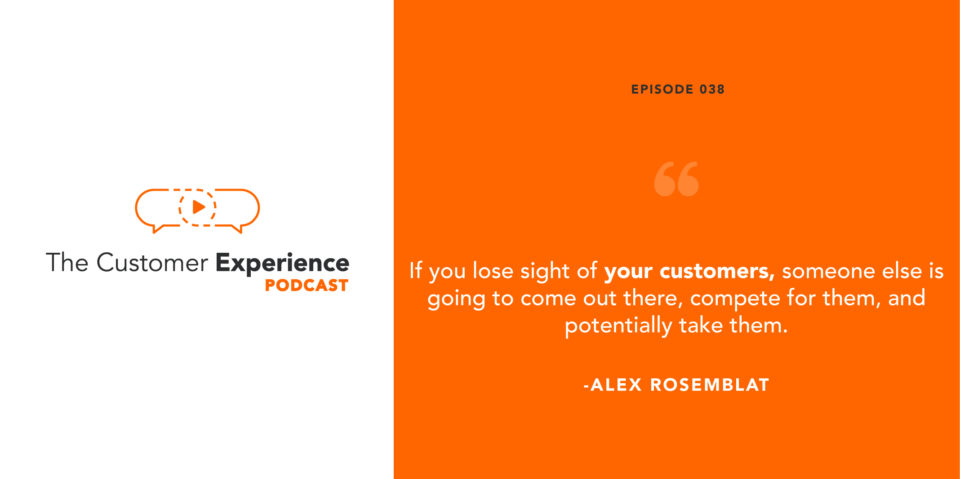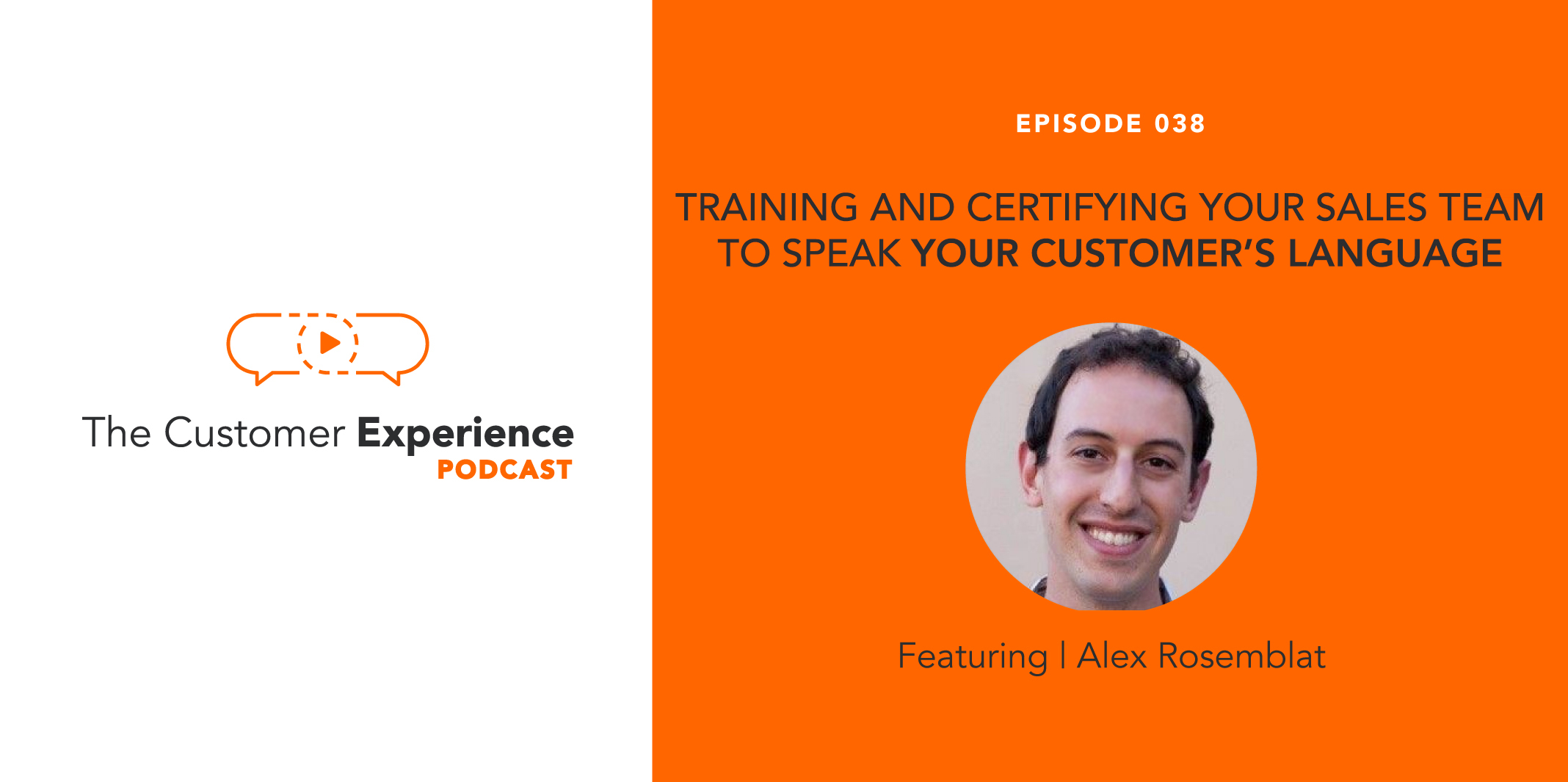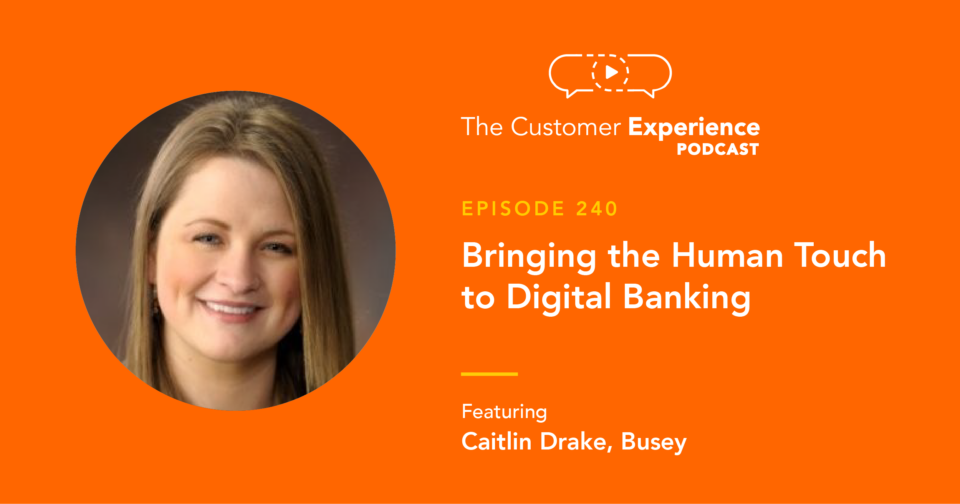
Apple Podcasts | Google Podcasts | Stitcher | Spotify
Do you know what language your customers speak? No, I don’t mean English or Spanish. When a customer has a different background, experience, and perspective than your own, it can be difficult to understand what their needs are and to communicate in a way that gives them confidence that you understand them. And part of that is a language gap.
Langauge can be a connector, as well as a point of friction. When we know the “insider” language and even the jargon of our potential customers, we build understanding and trust faster. Deeper than that are the cultural aspects of language – subtleties and nuances. So, how do you get a new sale rep there? Or how do you more quickly penetrate a specific vertical?
My guest on this episode of The Customer Experience Podcast helps navigate sales teams toward understanding and speaking a customer’s language.
Alex Rosemblat shares with us how he’s teaching salespeople to learn customer languages to build trust and to provide a better customer experience. With his tested and proven guidance, sales and marketing teams work together to hear, understand, and share back in their own words customers’ challenges, opportunities, and curiosities.
With more than a decade of enterprise software experience, Alex spent time at Symantec, VKernel, and Dell and earned his MBA at MIT Sloan School of Management. He currently serves as the VP of Marketing at Datadog.
Alex sets customer experience in a familiar context: As an employee of a company, it can be difficult to see the customer’s perspective. Customers don’t see what goes on behind the scenes (or in the “back of house”), so they only know about the direct points of contact and interaction in the “front of house.” That lack of information creates a variance between what a company thinks the customer experiences and what the customer actually experiences.
So what makes a great customer experience considering, understanding, and accepting a customer’s perception, because it’s the reality. By failing to thinking about how they experience your products, services, and people, you’re opening your company up to losing your customers. And, by the way, the language they use is an important part of that reality.

Listen to this episode to hear Alex discuss ways to connect with our customers and improve their experiences with our companies. Specific topics include:
- Identifying and learning our customer’s language
- Learning how to communicate deeper with our customers
- Connecting and aligning sales teams with marketing teams
- Training and certifying salespeople speak like your customers
- Building a curriculum to guide your sales team
- More!
Alex joined me by phone, so we don’t have the video clips here we have in other episode posts, so be sure to give the embedded audio a listen! His process is smart, tested, and effective.
Enjoy!
Training and Certifying Your Sales Team to Speak Your Customer’s Language
To listen to this episode, episodes we’ve already released, and episodes coming soon, please subscribe to The Customer Experience Podcast in your preferred podcast player:
> Apple Podcasts
> Google Podcasts
> Spotify
> Stitcher
As mentioned above, we always embed the full recording here in each podcast episode’s blog post.
So you can also listen in on Alex Rosemblat as he talks about learning and teaching your customer’s language right here…
Every Customer Represents a Community
When visiting a foreign country, we can find ourselves on the wrong side of a language barrier. Learning the basics that can help us get by (ordering coffee, asking for the bathroom, finding the right train, etc.) is essential for a satisfying travel experience. The locals will appreciate you taking the time to value their language and are often more welcoming.
In contrast, not taking that time to understand their language can create a rough experience. You’ve not built any bridge to meet people halfway. You’re unable to demonstrate that you did any prep work in advance. You’re not showing respect for the culture.
We recognize these communities abroad that have values and perspectives different from our norms – it’s one of the main reasons we travel! So why is it that we don’t take this time to experience and understand our customers’ communities and perspectives?
Again, it goes a long way toward building trust and building relationships.
Each Community Has Its Own Language
Every customer has developed her or his own set of language, values, and expectations of any given company. They each are driven by things they’re passionate about, things that interest them, and things they need or want. Wrapped around these ideas is their community – other customers and future customers who share similar values, communicate in similar ways, and have similar needs.
Alex references the tech community and television shows like Mr. Robot and Silicon Valley. They illustrate how complex and dynamic the tech community can appear to an outsider. Much like a foreign country, not being part of that community will leave someone feeling out of place. The culture captured and played with in those shows can be a barrier or hurdle en route to connecting and communicating with those on the “inside.”
And that is exactly the issue Alex is trying to solve. Companies will hire marketers, sales teams, and leaders who have no relation to the customers and communities their company serves. Without proper training and acculturation, our team members can make a customer feel alienated from our brands through those little “tells” that we don’t truly understand them.
So how do we overcome this customer language barrier? By creating an education platform for our teams to learn how to speak our customer’s language.
Crating Sales Training and Certification
Step #1: Get A Microphone
Find something that’s portable and nonintrusive that you can record a conversation with (like this or that). Because it’s key that you’re paying attention and actively listen when someone is telling you about themselves, find a way to record that so you can focus on each moment of the conversation.
Alex offers a few suggestions on who to talk with first:
- Company founders (if you’re at a start-up)
- Average customers or highest-value customers
- Experts in the subject you’re trying to learn about
- Respected, accomplished, and/or tenured team members who are customer-facing
The point is to find someone who is deeply rooted in your customer community. And, by the way, you’re likely serving several different communities – so you may do this in multiple layers.
Then start by asking them to take you through a day in their life. Any details from how they start their day, habits they practice, philosophies they follow, anything that may seem minute could be informative – capture these cultural ideas.
Alex cautions that follow up questions are where they money is. For example, asking someone what they do in the morning and settling for a reply like “I get up, eat, and go to work” won’t get you where you need to go. Though simple, there’s a lot to unpack in that message depending on your company’s products or services. If your business sells cookware, you might ask what they ate or how they cooked it.
The point of this exercise is to find the golden details that help you understand these people and their perspective and bring those details into your company’s people to broaden perspectives.
Step #2: Listen For “The Crinkle”
“The Crinkle,” as Alex calls it, is when the person you’re interviewing pauses or takes a moment to continue what they’re saying. This is when they’re processing what they should say. This can be because they don’t feel they can speak freely, they’re wondering if they should cover a detail up, or if there’s a better way to say something.
These pauses are usually attributed to something that’s deeply important to them – struggles, challenges, or issues they feel uncomfortable discussing.
If you listen for this moment and try to make them feel heard and understood, you’re likely to find valuable nuggets in what they have to say here. And they’ll appreciate you for showing empathy for them in this moment.
Step #3: Build Your Curriculum
Once you’ve captured the building blocks of your customer’s community, you can begin developing a curriculum. And you’ll likely be developing it constantly.
What’s especially important to building this educational material is creating a sequence of where to start and where to finish. Your “students” need to have context for the information they’re learning. It’s also important to understand that each student will have a perspective to overcome during their education.

The last part of administering a curriculum is understanding that people will struggle before they succeed. Alex says predicting that struggle and knowing an average length of time a student can take before overcoming it is crucial to this teaching.
Though you could just show someone the results of a lesson, having them struggle and then know the answer makes it “click” for them. He relates this to giving someone water after being in the desert.
Ultimately, the goal is to educate your sales teams on your customers, their language, their values, and their norms.
This is a process that Alex has received great feedback about – several salespeople he’s worked with not only thank him for the training and certification, they also ask him when the next courses are coming out.
Creating Behavior Change in Sales and Marketing
Alex leaves us with some great strategies on how to shift toward account-based marketing (ABM), which requires that sales and marketing work more closely and more effectively than ever. He mentions that in any company you’ll have people at the opposite ends of a bell-curve. Some will be against the change while others will be excited to learn.
Alex and his team always start with a pilot group – the employees who want to get a competitive edge in their work. People within this smaller, voluntary group want to learn and usually enjoy that “aha” moment when going through the curriculum Alex’s team provides. Once they get there, they’re set loose to apply the knowledge they’ve learned to current issues in the company and its processes.
Alex mentions that as coworkers see the results of this education, a waiting list begins to form to enter the curriculum. So that’s why his team recommends starting small and then letting other employees see the results. Staff that might’ve missed the first round can try to get in on a second and third.
The goal: that our marketers and sales teams can work together to providing a better customer experience.
>> Note: a gentleman who’s written two books on ABM , Sangram Vajre, joins us in a few weeks here on the podcast. Subscribe today through the links below! In the meantime, check out his the recent release ABM is B2B.
This post is based on an interview with Alex Rosemblat, VP of Marketing at Datadog.
If you want more conversations about how marketing, sales, and customer success leaders build stronger relationships with and deliver better experiences to their customers, subscribe to The Customer Experience Podcast …
While you’re there, please take a moment to leave a rating or review – it’s very helpful to the show and its growing community.
CX Conversations to Hear Right Now:
- “No, Your Customer Isn’t Always Right” with Jaime Casap (Chief Education Evangelist, Google)
- “Sales Strategy Mistakes and How To Fix Them” with Jeremy Donovan (SVP of Sales Strategy, SalesLoft)
- “4 Things Every Customer Wishes You Knew About Them” with Mike Redbord (GM of Service Hub, HubSpot)
CX Conversations to Hear Very Soon:
- Member of the original HubSpot team and HubSpot sales executive Dan Tyre (HubSpot)
- VPs of Field Operations Lance Risser and Levi Ayriss (Dutch Bros Coffee)
- Cofounder and Chief Evangelist Sangram Vajre (Terminus)
I welcome your podcast feedback! Please reach out by emailing me at “Ethan (at) BombBomb (dot) com” or by connecting with me on LinkedIn.
Get Your Sales Team Face to Face Earlier and More Often
If your sales process depends on building trust and building relationships (whose doesn’t!?), then you’ll want to read and share this book. It provides the complete what, why, who, when, and how of the “relationships through video” movement.
The definitive guide to better business communication was received as the Amazon #1 bestseller in Business Sales, Business Communication, and Customer Relations, the 800-CEO-Read/Porch Light Books #1 bestseller in its opening week of release, and a Barnes & Noble bestseller it its opening week of release.








